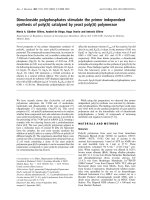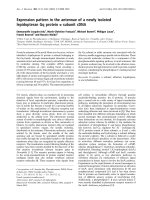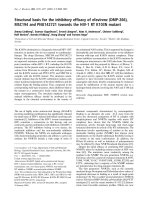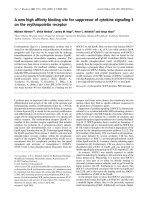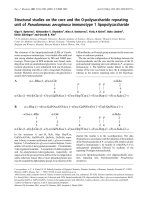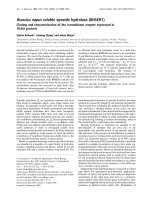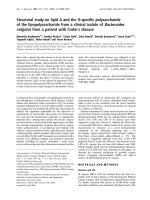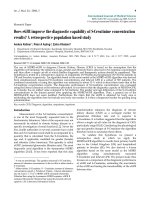Báo cáo y học: " Chiropractic wellness on the web: the content and quality of information related to wellness and primary prevention on the Internet" potx
Bạn đang xem bản rút gọn của tài liệu. Xem và tải ngay bản đầy đủ của tài liệu tại đây (222.25 KB, 7 trang )
RESEARCH Open Access
Chiropractic wellness on the web: the content
and quality of information related to wellness
and primary prevention on the Internet
Marion Willard Evans Jr
1*
, Stephen M Perle
2
, Harrison Ndetan
3
Abstract
Background: The Internet has become a common source of information for patients wishing to learn about
health information. Previous studies found information related to back pain poor and often contradictory to
current guidelines. Wellness has become a common topic in the field of chiropractic and accrediting agencies
have standards on delivery of wellness-based con tent in college curricula as well as directives for clinical
applications. The purpose of this study was to evaluate the quality of the information on the Internet using the
terms “chiropractic wellness,” or “wellness chiropractic”.
Methods: Five commonly used search engines were selected and the first 10 sites found using the strategy above
were evaluated by two raters. Demographic assessments of the sites were made along with whether they were
Health on the Net Foundation (HON) certified, contained standard wellness content, mentioned any Healthy
People Focus Areas, and other chiropractic topics. Kappa statistics compared inter-rater agreement.
Results: Potential patients appeared to be the audience 87% of the time and a private doctor of chiropractic
appeared to be the typical site owner. The sites usually promoted the provider. No sites displayed HON
certification logo nor did any appear to meet the HON certification criteria. Twenty-six sites (55%) promoted
regular physical activity in some manner and 18 (38%) had information on health risks of tobacco. Four (9%) had
mental health or stress-reduction content but none had information supportive of vaccination. Some had
information contradictory to common public health measures.
Conclusions: Patients searching the Internet for chiropractic wellness information will often find useless
information that will not help them maintain health or become well. Most simply market the chiropractic practice
or allow for a patients to provide personal information in exchange for more ‘wellness’ information. More research
should be done on how providers determine site content, pay any attention to the details on their sites, or agree
with content as some appear to be prefabricated sites. Website content could be enhanced by sharing of
information from reputable sources like US Centers for Disease Control, the National Institutes of Health and other
authoritative sources. HON certification should also be sought.
Background
The Internet has become a common source of informa-
tion for patients wishing to learn about health and med-
ical information [1-4]. Internet sites can now be set up
by virtually anyone and may contain informatio n simply
chosen at will by the site developers. Butler and Foster
found information related to back pain on the Internet
to be of poor quality with information often contradic-
tory to current guidelines for management of back pain
[5]. Studies on home management of childhood fever
and depression on the Internet were also rated poorly in
separate studies [6,7].
Specific evaluations of Internet-based information
have been performed for back and spinal pain, scoliosis
and spine-related education [8-10]. Li and colleagues
searched the Internet for information on back pain
using a search strategy of what a typical patient might
utilize and found a lack of quality control, problems
* Correspondence:
1
Texas Chiropractic College, Pasadena, TX, USA
Full list of author information is available at the end of the article
Evans et al. Chiropractic & Manual Therapies 2011, 19:4
/>CHIROPRACTIC & MANUAL THERAPIES
© 2011 Evans et al; licensee BioMed Central Ltd. This is an Open Access article distributed under the terms of the Creative C ommons
Attribution License ( which perm its unrestricted use, distribution, and reproductio n in
any medium, provided the original work is properly cited.
with credibility of information on the sites, and a minor-
ity of sites containing evidence-based information related
to back pain [8]. Mathur and associates investiga ted the
quality of information related to management of scoliosis
on Internet sites and stated that the information was
typically of limited quality and of poor information value
[9]. They suggested that physicians assume more respon-
sibility for the content of information on their sites. In a
review of readability of sites related to spine-related edu-
cational information on websites reading levels were typi-
cally way above recommended levels averaging over the
10
th
grade reading level [10].
Wellness has become a common topic in the field of
chiropractic and the accrediting agency for chiropractic
degree programs has standards on delivery of wellness-
based content in college curricula as well as directives for
practical application at the clinical level [11]. In addition,
the United States (US) has establishe d goals for the
nation through the Healthy People (HP) initiat ives that
should guide content provided by all health care provi-
ders and community health programs related to wellness
and primary preventio n [12]. The Associati on of Chiro-
practic Colleges and the American Chiropractic Associa-
tion, the largest trade group in the US for the
chiropractic profession have mission statements suppor-
tive of these efforts [13,14]. The Chiropractic and Osteo-
pathic College of Australasia has within its objectives to;
“promote the integration of chiropractors and osteopaths
into the broader community health team” and; to, “parti-
cipate in activities related to public health” [15]. Wellness
content then should be content that is congruent with
the recommendations of such docume nts mentioned
above, not in opposition to accepted public or commu-
nity health measures, and not simply advertisement for
servi ces in a provider’s office. The purpose of this study
was to specifically evaluate the quality of the information
patients searching the Internet with the terms “chiroprac-
tic wellness,” or “wellness chiropractic” would find based
on whether the information is in line with current,
accepted health promoting measures related to general
health and wellness described above. Further, sites were
evaluated to see if they followed the criteria called for by
Health on the Net Foundation (HON) .
ch/ which provides guidelines for responsible health and
medical information sites on the Internet. Sites were also
assessed as to whether they contained typical chiropractic
terms such as subluxation, innate inte lligence, or spinal
care and whether the presence of these terms would pre-
dict more or less health promotion and wellness advice
available on the site.
Methods
The search terms selected were “chiropractic wellness,”
and “wellness chiropractic.” These terms are commonly
used in signage on chiropractic offices in marketing
materials so the rationale or aim of the investigators was
to see what content this would net on the World Wide
Web and evaluate that content. Five search engines
commonly used by laypersons were selected. These were
Google.com, Yahoo.com, Microsoft Bing.com, Ask.com,
and AOL.com. These were selected because of their
rankings as the most used websites from http://www.
comscore.com. The first 10 sites fo und anywhere on the
web b y using the strategy above on each search engine
were selected for evaluation.
Demographic assessments of the sites were made such
as determining the audience they were aimed at, the
source of the website, the purpose, whether they were
Health on the Net Foundation (HON) certified http://
www.hon.ch/, whether they contain ed standard wellness
content, mentioned any HP Focus Areas, HP Ten Lead-
ing Health Indicators, and t ypical chiropractic topics.
The typical chiropractic topics determined if the site
mentioned subluxation, prevention of spinal pain, innate
or presented anti-vaccination, anti-drug or anti-medical
viewpoints. The site was judged using the 8 principles
defined by HON:
1–Information must be authoritative giving qualifica-
tions of authors
2–Purpose of the website should be apparent
3–Confidentiality that respects the privacy site users
4– Information must be documented: citing sources
and dates of medical information
5–Justification of claims
6–Website contact details should be apparent
7–Disclosure of funding sources
8–Advertising policy stated that clearly distinguishes
advertising from editorial content
Data about websites were placed in an Excel spread-
sheet with assessment of ea ch of the criteria described.
Assessment was made separately by two researchers
(Rater1 and Rater2). Da ta was reviewed and converted
into SPSS version 16 (SPSS Inc, Chicago, IL) for analysis.
Primarily, frequencies were generated on the web content
of each site as reviewed by Rater1 and Rater2. Kappa sta-
tistics was used to assess agreement beyond chance
between the two reviewers. Kappa value is reported as a
percent and commonly interpreted as follows: <20% neg-
ligible improvement over chance agreement alone,
21-40% minimal improvement, 41-60% fair, 61-80% good
improvement, 81-92% very good, and 93-100% excellent
[16]. The main chiropractic topic assessed was whether
or not a webpage specifically mentioned subluxation,
innate and/or spinal pain. Odds ratios (OR) and 95%
confidence intervals (CI) were computed from binary
cross-tabulations that assessed whether or not sites
that mentioned each of those chiropractic topics
(such
as ‘subluxation’, ‘innate’, or management of spinal
Evans et al. Chiropractic & Manual Therapies 2011, 19:4
/>Page 2 of 7
conditions) were also likely to mention anti-vaccination,
anti-drug, or anti-medical information. It should be stated
that the term ‘subluxation’ is a chiropractic term sugges-
tive of nerve inte rference occurring when spinal align-
ment or function is altered by such events as trauma and
that innate refers to the body having an innate or inborn
ability to heal itself if spinal nerve interference is not pre-
sent. These terms are unique to chiropractic in a histori-
cal sense and are commonly used by some practitio ners
adhering to a traditional belief that spinal conditions are
a source of other diseases; hence, the interest in the eva-
luatorsastopresenceornon-presenceoftheseterms
and their potential for effect modification of any analysis.
Results
General purpose and content of the site
A total of 47 unique websites were obtained from the 5
search engines for testing. All of the sites appear to be
sites in North America. Nineteen sites were captured
under the term ‘chiropractic wellness,’ and 18 with the
term ‘wellness chiropractic’ and 10 of these were found
with both search phrases. The results reported below
are mainly based on one reviewer (Rater2), however,
details on both reviewers as well as percent agreement
between them are present in the tables.
Potential patients appeared to be the audience the
websites were aiming at 87% of the time and a private
doctor of chiropractic appeared to be the site owner
87% of the time. The purpose of the site was typically to
promote the provider (87% of sites). None of the web
sites displayed HON certification logo nor did any
appear to meet the HON certification criteria. On e site
appeared to offer authoritative information and 1 stated
the purpose of t he site. Thirteen had statements related
to confidentiality of t he site. Only 2 had referenced and
dated content and 2 had justification of claims. Contact
detail s were unavailable on >90% of sites. Demographics
of websites and Rater1 and 2 responses with kappa sta-
tistics appear in table 1.
General health-related content on the site
Twenty-six sites (53%) promoted regular physical activ-
ity in some m anner and 18 (38%) had information on
tobacco or health risks of smoking. Four (9%) had men-
tal health or stress-reduction content but none had
information supportive of vaccination. Other data on
general health information is noted in table 2 along with
both raters’ assessments and kappa statistics.
Healthy People content areas
No website specifically mentioned the topi c of HP 2010
but 25 (53%) had some content that fell loosely under
one of the HP headings. For example, one site had some
content related to cancer prevention and one had
information on prevention of stroke or heart disease but
none had information specific to prevention of kidney
disease, disability, secondary conditions, or family plan-
ning. Content related to prevention falling under HP
Focus areas was rare on all of the websites reviewed.
Table 3 lists content-specific information related to HP
Focus areas.
Table 1 General website demographic information and
rater responses
Variable Rater1 n
(%)
Rater2 n
(%)
Kappa
(%)
Audience
Patient 44(94) 41(87) 100
Chiropractor 3(6) 3(7)
Gen public 0(0) 2(4)
Missing 0(0) 1(2)
Owner
Chiropractor 43(92) 41(87) 100
Non-profit 2(4) 3(7)
Commercial 2(4) 2(4)
Missing 0(0) 1(2)
HON certified
Yes 0(0) 0(0) 100
No 47(100) 47(100)
Info is authoritative
Yes 0(0) 1(2) 100
No 47(100) 46(98)
Purpose defined
Product 3(6) 1(2) 98
Service 0(0) 2(4)
Provider 44(94) 41(88)
Profession 0(0) 2(4)
Missing 0(0) 1(2)
Confidentiality
Yes 0(0) 13(28) 72
No 47(100) 34(72)
Info documented, referenced,
dated
Yes 0(0) 2(4) 96
No 47(100) 45(96)
Justification of claims
Yes 0(0) 2(4) 96
No 47(100) 45(96)
Website contact details
Yes 0(0) 2(6) 94
No 47(100) 44(94)
Discloses funding
Yes 0(0) 0(0) 100
No 47(100) 47(100)
Advertising policy
Yes 0(0) 1(2) 98
No 47(100) 46(98)
Evans et al. Chiropractic & Manual Therapies 2011, 19:4
/>Page 3 of 7
Among the H P Leading Health Indicators, 25 (53%)
sites specifically mentioned a topic that would fall under
one of them. Some mention of physical activity (PA)
was noted on 26 (53%) of sites and 21 (45%) mentioned
issues related to overweight and obesity. As stated, 18
(38%) had some information related to the health issues
associated with tobacco use. Only 1 site contained any
information on injury and violence prevention and no
site had information on the benefits of immunization,
responsible sexual behavior, vision and hearing pro-
blems, or substance abuse.
Chiropractic topic information
Thirty-six (77% of sites) contained information on chiro-
practic ‘subluxation’ and 28 (60%) had information o n
‘innate.’ Thirty-one (66%) sites had information related
to prevention of spinal pain. Regarding information
expressing negative aspects of medical interventions
or vaccines, 16 (34%) of sites contained obvious anti-
vaccination information, 16 (34%) had information that
was anti-drug (prescription or medical use of drugs),
and 14 (30%) had general anti-medical information
related to the medical profession. Interestingly, no site
had specific HP Focus Area information on the topic of
arthritis, osteoporosis, and chronic back conditions.
Complete responses from reviewers and kappa ratios of
chiropractic information are listed in table 4.
Sites that mentioned ‘subluxation’ were more likely to
have anti-vaccine information compared to sites that did
not [OR = 5.7(95% CI,0.6-50.6)], were more likely to
have anti-drug informatio n [OR = 5.7(95%CI,0.6-50.6)],
and to have anti-medical information [OR = 4.5(95%
CI,0.5-40.3)]. However, these did not approach statistical
significance due to small cell numbers. Sites that men-
tioned ‘innate’ were more likely to contai n anti-vaccine
information [OR = 7.5(95%CI,1.4-39.0)], were more
likely to have anti-drug information [OR = 7.5(95%
CI,1.4-39.0)], and more likely to have anti-medical infor-
mation on them as well [OR = 2.0(95%CI,1.4-2.9)]. Sites
that mentioned spinal pain were more likely to contain
anti-vaccine information a s well when compared to
those that did not, [OR = 4.9(95%CI, 0.9-26.0)], more
likely contained anti-drug information [OR = 12.1(95%
CI,1.4-105.0)], and more likely to contain anti-medicine
information, [OR = 9.4(95%CI,1.0-81.0)], though not all
were statistically significant at the 95% confidence level.
Discussion
Reviewer agreement levels were generally good to excel-
lent. In cases where variation occurred it was often due
to the depth of site review. Some information may have
appeared in the opening page of a website but on
others, information was on panels that required the
reviewer click several tabs to reach it. When information
was not visible on the website in a prominent manner it
was harder t o locate and probably accounts f or some
variation between reviewers. In addition, reviewers used
their own judgment as to whether sites contained infor-
mation consistent with HP initiatives. Perhaps a good
example is diet and health. Some s ites contained in for-
mation on diet and health. However, many of those
were to market a nutritional product or supplement and
may not have indicated a level of dietary information
related to HP initiatives. This may have accounted for
variation among reviewers in general.
The Internet will get more and more use as a poten-
tial so urce of i nformation on health and we llness.
Smart-phone technology now allows a search from
almost anywhere. The purpose of this study was to see
what wellness-oriented content would appear on sites
the public would likely come across on a routine searc h
of chiropractic wellness. The findings presented here
indicate a lack of sound wellness and health promotion
information available on most of the sites analyzed.
Table 2 General health and wellness topics mentioned on
websites
Variable Rater1 n
(%)
Rater2 n
(%)
Kappa
(%)
Site promotes physical activity
Yes 17(36) 26(53) 83
No 30(64) 22(47)
Smoking cessation information
Yes 2(4) 18(38) 66
No 45(96) 29(62)
Mental health and stress
reduction
Yes 9(19) 4(9) 89
No 38(81) 43(91)
Safety (helmet, seatbelt use)
Yes 1(2) 0(0) 98
No 46(98) 47(100)
Healthy diet
Yes 15(32) 27(57) 74
No 32(68) 20(43)
Alcohol use in moderation
Yes 0(0) 0(0) 100
No 47(100) 47(100)
Safe sex practices
Yes 0(0) 0(0) 100
No 47(100) 47(100)
Substance abuse
Yes 0(0) 0(0) 100
No 47(100) 47(100)
Supportive of vaccines
Yes 0(0) 0(0) 100
No 47(100) 47(100)
Evans et al. Chiropractic & Manual Therapies 2011, 19:4
/>Page 4 of 7
Research into what consumers look for to dete rmine
thecredibilityofanInternetsitemaybeacausefor
more concern over content. One study found that peo-
ple look more at the professional design of the site,
whether they can get, “a quick lay-out of the site”,the
user-friendliness of the site, and speedy interface times
rather than if the content is evidence-based or sup-
ported by the scientific literature [17]. This is unfortu-
nate but understanda ble. After all, these are laypersons
and not providers. This same study found that patient
markers for quality included if it “sounded plausible,”
sounded “scientific,” looked “trustworthy.” These have
little to do with actual viability of content.
The depth of information on the sites analyzed was
poor and was rarely evidence-based. Many sites may
have mentio ned one should walk for example but there
was no evidence of information related to PA Guidelines
for Americans [18] and information related to how one
could get PA into their daily lives. This study also
Table 3 Healthy People content information found on
websites
Variable Rater1 n
(%)
Rater2 n
(%)
Kappa
(%)
Site mentions HP initiatives
Yes 0(0) 0(0) 100
No 47(100) 47(100)
HP Focus Areas mentioned
Yes 25(53) 25(53) 100
No 22(47) 22(47)
Access to quality health care
Yes 0(0) 0(0) 100
No 47(100) 47(100)
Conditions Arthritis, osteoporosis,
chronic back pain
Yes 9(19) 0(0) 81
No 38(81) 47(100)
Cancer prevention
Yes 0(0) 1(2) 98
No 47(100) 46(98)
Kidney Disease
Yes 0(0) 0(0) 100
No 47(100) 47(100)
Diabetes
Yes 3(6) 0(0) 94
No 44(94) 47(100)
Disability, secondary cond.
Yes 0(0) 0(0) 100
No 47(100) 47(100)
Educ. and community-based
programs
Yes 0(0) 0(0) 94
No 44(94) 47(100)
Vision and hearing problems
Yes 0(0) 0(0) 100
No 47(100) 47(100)
Select Leading Health Indicators
Physical activity
Yes 17(36) 25(53) 83
No 30(64) 22(47)
Overweight/obese
Yes 9(19) 21(45) 74
No 38(81) 26(55)
Tobacco use
Yes 2(4) 8(17) 87
No 45(96) 39(83)
Responsible sexual behavior
Yes 0(0) 0(0) 100
No 47(100) 47(100)
Mental health
Yes 1(2) 10(21) 81
No 46(98) 37(79)
Injury and violence
Yes 1(2) 1(2) 100
Table3HealthyPeoplecontentinformationfoundon
websites (Continued)
No 46(98) 46(98)
Immunization
Yes 0(0) 0(0) 100
No 47(100) 47(100)
Table 4 Chiropractic characteristics and demographic
information from websites
Variable Rater1 n
(%)
Rater2 n
(%)
Kappa
(%)
Site specifically mentions
subluxation
Yes 35(75) 36(77) 99
No 12(25) 11(23)
Site specifically mentions innate
Yes 34(72) 28(60) 87
No 13(28) 19(40)
Mentions preventing spine pain
Yes 37(79) 31(66) 87
No 10(21) 16(34)
Anti-vaccine information in
website
Yes 14(30) 16(34) 96
No 33(70) 31(66)
Anti-medical information on
website
Yes 19(40) 14(30) 89
No 28(60) 33(70)
Anti-drug information on
website
Yes 19(40) 16(34) 94
No 28(60) 31(66)
Evans et al. Chiropractic & Manual Therapies 2011, 19:4
/>Page 5 of 7
demonstra tes that some chiropractors (those with web
sites that are highly ranked by the search engines used)
apparently still support the notion that chiropractic care
is a viable substitute for medical care. Anti-medical,
anti-drug, and anti-vaccine rhetoric was often displayed
prominently on the sites eva luated. This is concerning.
Worth noting is that several sites had very near identical
content apparently having purchased a pre-manufactured
website from one of a small number of vendors. Many
practitioners may be purchasing these and paying little
attention to the information that is on the sites. Never-
theless, content was poor on most sites lacking legitimate
evidence-based wellness information. This is ultimately
the responsibility of the provider.
Patients need information on how to become healthy
and stay healthy. Many of the health conditions listed in
HP documents and that this projec t assessed are the
common causes of premature morbidity and mortality
in Americans and typically, in a minority of sites was
there any information that would likely help a patient
restore or gain healthy ground. The sites typically mar-
keted t he chiropractor and offered promotional materi-
als for services offered in the clinic and not wellness
measures common to preventive medici ne or health
promotion. Even specific information on prevention of
reoccurrence of back pain was scant on most sites. The
anti-public health messaging could actually be seen by
some as anti -prevention, therefore anti-wellness. This
was discouraging as well since it could be seen on
approximately 1/3 of sites reviewed.
Limitations of the study
There are some specific limitations of this study. First,
this was a review of a minimum number of sites and
they may not be representative of all chiropractic sites.
Second, two reviewers who are researchers made the
reviews and there is bias inherent to that process. How-
ever, agreement was consistent most of the time. Third,
many content areas related to HP initiatives clearly
would not be expected to be found on a site to promote
an individual chiropractor as was the apparent intent of
most of the websites reviewed. Therefore, content like
safe sex practices, vision and hearing issues are not
likely to be found here even if they might benefit
patients wh o view the sites. Lastly, all of the sites netted
by the search on these most popular search engines
appear to be in North America and therefore, we cannot
assume any of the results w ould generalize to Europe,
Australia, or other parts of the world.
Conclusions
Patients sea rchi ng the Internet for chiropractic wellness
information will often find a lot of poorly done, useless
information that will not hel p them maintain health or
become well. Most of t he time it simply markets the
chiropractic practice and lists services that they offer i n
the office or allows for a patient to provide personal
information in exchange for more ‘wellness’ information.
This equates to marketing and practice building. More
research should be done on how providers determine
site content, whether they pay any attention to the
details presented on their sites, and whether they even
agree with it. Website content could be enhanced by
sharing of information from reputable sources like the
US Centers for Disease Control and Prevention, the
National Institutes of Health and other authoritative
sources. HON certification should be sought as well.
Inform ation that is illogical or contr adictory to current,
accepted public health and wellness practices should be
removed to better serve patients and potential patients
who visit these sites. This could serve to improve the
cultural authority of chiropractic as providers interested
in wellness in the process. Regulatory boards should
begin to evaluate the advertising content on these sites
as some of it seems to violate board rules on ethics and
advertising.
List of abbreviations
AOL: America Online search engine; Cl: confidence interval; HON: Health on
the Net Foundation; HP: Health People initiative of the United States; OR:
odds-ratio; PA: physical activity; US: United States.
Author details
1
Texas Chiropractic College, Pasadena, TX, USA.
2
University of Bridgeport,
Bridgeport, CT USA.
3
Parker Research Institute, Dallas, TX, USA.
Authors’ contributions
SMP conceptualized the idea for the study, developed the spreadsheet for
comparative analysis, was a reviewer of websites, and helped construct and
review the manuscript. MWE assisted in development of methods of
assessment, reviewed the websites, assisted in data analysis and
interpretation, and primarily constructed the manuscript. HN performed the
statistical analysis, helped create all tables. All authors reviewed and edite d
the manuscript and approved the final manuscript.
Competing interests
The authors are all primarily researchers and academics and acknowledge
no competing interests related to the research presented.
Received: 28 October 2010 Accepted: 2 February 2011
Published: 2 February 2011
References
1. Shepperd S, Charnock D, Gann B: Helping patients’ access high-quality
health information. BMJ 1999, 319:764-766.
2. Krempec J, Hall J, Biermann JC: Internet use by patients in orthopedic
surgery. Iowa Orthop J 2003, 23:80-82.
3. Brooks BA: Using the Internet for patient education. Orthop Nurs 2001,
20:69-77.
4. Aslam N, Bowyer D, Wainwright A, Theologis T, Benson M: Evaluation of
Internet use by pediatric orthopeadic outpatients and the quality of
information available. J Pediatr Orthop B 2005, 14:129-133.
5. Butler L, Foster NE: Back pain online: a cross-sectional survey of the
quality of web-based information on low back pain. Spine 2003,
28:395-401.
Evans et al. Chiropractic & Manual Therapies 2011, 19:4
/>Page 6 of 7
6. Impicciatore P, Pandolfini C, Casella N, Bonati M: Reliability of health
information for the public on the World Wide Web: systematic survey of
advice on managing childhood fever at home. BMJ 1997, 314:1875-1879.
7. Griffiths KM, Christensen H: Quality of web-based information on
treatment of depression: cross-sectional survey. BMJ 2000, 25:2932-2939.
8. Li L, Irvin E, Guzmán J, Bombardier C: Surfing for back pain patients: the
nature and quality of back pain information on the internet. Spine 2001,
26:545-557.
9. Mathur S, Shanti N, Brkaric M, Sood V, Kubeck J, Paulino C, Merola AA:
Surfing for scoliosis: the quality of information available on the Internet.
Spine 2005, 30:2695-2700.
10. Vives M, Young L, Sabharwal S: Readability of spine-related patient
education materials from subspecialty organization and spine
practitioner websites. Spine 2009, 34:2826-2831.
11. The Council on Chiropractic Education: Standards for doctor of
chiropractic programs and requirements for institutional status.
Scottsdale, AZ; 2007.
12. United States Department of Health and Human Services: Healthy People
2010. Understanding and Improving Health. [lthypeople.
gov/], [Online] [cited 2010 Aug 12].
13. American Chiropractic Association: Wellness Model. [today.
org/level2_css.cfm?T2ID=117&T1ID=10&ID=10&searchQuery=wellness+and
+health+promotion#109], [Online] [cited 2011 Jan 24].
14. Association of Chiropractic Colleges: Paradigm on Wellness. [http://www.
chirocolleges.org/paradigm_scope_practice.html], [Online] [cited 2010 Jul 10].
15. Chiropractic and Osteopathic College of Australasia: Objectives of the college.
[ [Online] [cited 2010 Oct 28].
16. Byrt T: How good is that agreement? Epidemiol 1996, 7:561.
17. Eysenbach G, Köhler C: How do consumers search for and appraise
health information on the world wide web? Qualitative study using
focus groups, usability tests, and in-depth interviews. BMJ 2002,
324:573-577.
18. United States Department of Health and Human Services: 2008 Physical
Activity Guidelines for Americans: Be active, healthy, and happy. [http://
www.health.gov/paguidelines], [Online] [cited 2010 Aug 10].
doi:10.1186/2045-709X-19-4
Cite this article as: Evans et al.: Chiropractic wellness on the web: the
content and quality of information related to wellness and primary
prevention on the Internet. Chiropractic & Manual Therapies 2011 19:4.
Submit your next manuscript to BioMed Central
and take full advantage of:
• Convenient online submission
• Thorough peer review
• No space constraints or color figure charges
• Immediate publication on acceptance
• Inclusion in PubMed, CAS, Scopus and Google Scholar
• Research which is freely available for redistribution
Submit your manuscript at
www.biomedcentral.com/submit
Evans et al. Chiropractic & Manual Therapies 2011, 19:4
/>Page 7 of 7

